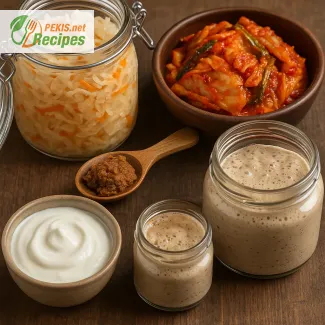
Fermentation turns everyday cooking into nutrient-rich meals full of flavor, texture, and balance. Rooted in ancient traditions from Asia to Europe, it enhances food with probiotics, vital vitamins, and deep umami character. Simple additions like kimchi, miso, or sourdough elevate ordinary dishes, supporting gut health while reducing food waste. Blending traditional methods with modern creativity, fermentation offers endless ways to make home cooking more dynamic, nourishing, and sustainable.
Fermentation as the hidden key to flavor and nutrition
Unlocking the science and culture behind fermented foods
Fermentation has moved from being an old preservation method to becoming a modern trend in home cooking. Beyond simply keeping food fresh, it introduces layers of flavor, texture, and nutrition that elevate ordinary meals into something extraordinary. From tangy kimchi to creamy yogurt, fermented foods bring depth to the plate while enriching the gut microbiome.
A brief history of fermentation traditions
The roots of fermentation go back thousands of years, when communities used natural microorganisms to preserve harvests and enhance taste. Ancient civilizations in China, Mesopotamia, and Egypt relied on fermentation to produce beer, bread, and pickled vegetables. In Europe, sauerkraut and cheese became staples, while in Asia, soy sauce and miso defined culinary identity. These traditions prove that fermentation is not just about survival, but also about innovation and cultural heritage.
Why fermentation matters today
Fermentation is not only about preservation; it transforms ingredients into nutrient-rich, digestible, and flavorful food. Scientific studies highlight its ability to increase levels of vitamins B and K, create beneficial probiotics, and enhance bioavailability of minerals like iron and zinc. This means a jar of fermented vegetables or a batch of sourdough bread does more than please the palate – it nourishes the body.
Practical ideas for everyday cooking
Incorporating fermented foods into daily meals does not require professional skills. With a few simple tricks, anyone can enrich their cooking:
- Add a spoonful of kimchi or sauerkraut to grain bowls for crunch and acidity.
- Stir miso paste into soups or marinades for deep umami flavor.
- Use fermented chili sauces for heat with complexity rather than flat spiciness.
- Whisk yogurt or kefir into dressings for creamy tang.
- Bake with sourdough starter to create bread that is both digestible and aromatic.
These small adjustments bring dimension and balance, allowing simple dishes to feel complete.
Flavor balance and culinary creativity
Fermented foods deliver acidity, saltiness, and umami, three elements that balance sweetness, fat, and bitterness in recipes. By layering these flavors, even the most basic meal gains sophistication. For example:
- Fermented soy sauce balances sweetness in stir-fries.
- Pickled cucumbers cut through the richness of smoked meats.
- Kombucha reductions add brightness to desserts.
Creative pairing goes beyond recipes. The key is experimenting with contrasts – salty with sweet, sharp with creamy – to achieve a dynamic plate.
Everyday health benefits
Regularly adding fermented foods to your diet supports gut health, strengthens the immune system, and contributes to overall vitality. The natural probiotics promote better digestion, while organic acids may help regulate blood sugar levels. For those interested in sustainable living, fermentation is also a way to reduce waste, turning surplus vegetables into long-lasting pantry staples.
Inspiration from traditional and modern kitchens
Across cultures, fermentation remains a foundation of culinary identity:
- In Japan, miso and natto symbolize heritage and health.
- In Korea, kimchi represents both everyday food and communal tradition.
- In Europe, cheeses, beers, and wines are timeless examples of fermentation mastery.
- In modern kitchens, chefs experiment with kombucha glazes, fermented garlic honey, or even cacao fermentations for chocolate.
This balance between tradition and innovation shows why fermentation resonates so strongly with today’s cooks.
Simple tricks to get started
For home cooks ready to try, the journey can start with small steps:
- Begin with fermented yogurt or kefir as breakfast staples.
- Experiment with quick pickles using salt brines.
- Replace vinegar with fermented condiments for layered acidity.
- Keep a sourdough starter alive for bread, pancakes, and even desserts.
These tricks are practical, approachable, and rewarding – both for taste and for health.
Fermentation in cooking
Fermentation is more than a trend; it is a culinary revolution that transforms everyday cooking into something richer, healthier, and more creative. By combining practical ideas, traditional wisdom, and modern experimentation, it opens a door to endless flavor combinations. Whether adding a spoonful of sauerkraut to a salad or baking with a sourdough starter, the result is the same: meals that are alive with taste, culture, and nourishment.
FAQ questionWhat are the main health benefits of fermented foods?
Fermented foods provide natural probiotics that support gut health, improve digestion, and may boost the immune system. They also enhance the absorption of vitamins and minerals.
FAQ questionHow can I easily add fermented foods to daily meals?
Simple steps include adding kimchi or sauerkraut to grain bowls, stirring miso paste into soups, or using yogurt and kefir in dressings and smoothies.
FAQ questionDo fermented foods always taste sour?
Not necessarily. While many have a tangy note, others like miso, cheese, or soy sauce develop savory umami flavors without strong acidity.
FAQ questionIs fermentation safe to try at home?
Yes, when following basic hygiene and using the right salt ratios or starter cultures, home fermentation is safe and rewarding. Always use clean jars and fresh ingredients.
FAQ questionWhich traditional dishes are based on fermentation?
Examples include kimchi in Korea, sourdough bread in Europe, miso in Japan, and sauerkraut in Central Europe, all of which show the global importance of fermentation.
PEKIS – professional chef and recipe developer with over 25 years of experience, specialized in European and international cuisine. For this article, I draw on years of working with fermented foods, from crafting sourdough breads to experimenting with kimchi, kombucha, and miso in everyday cooking.